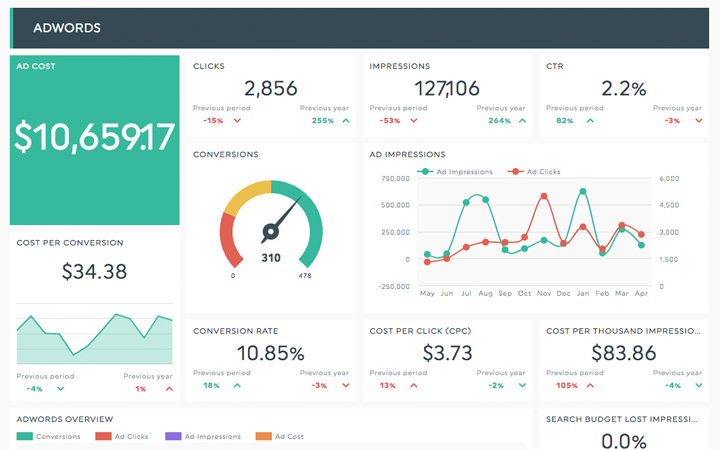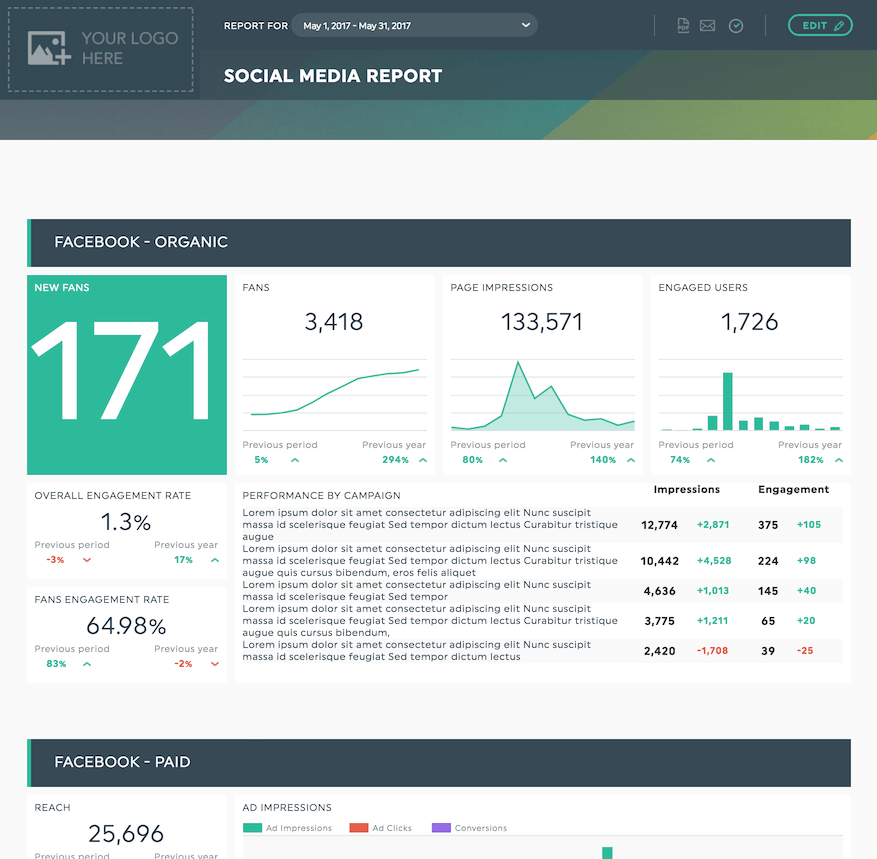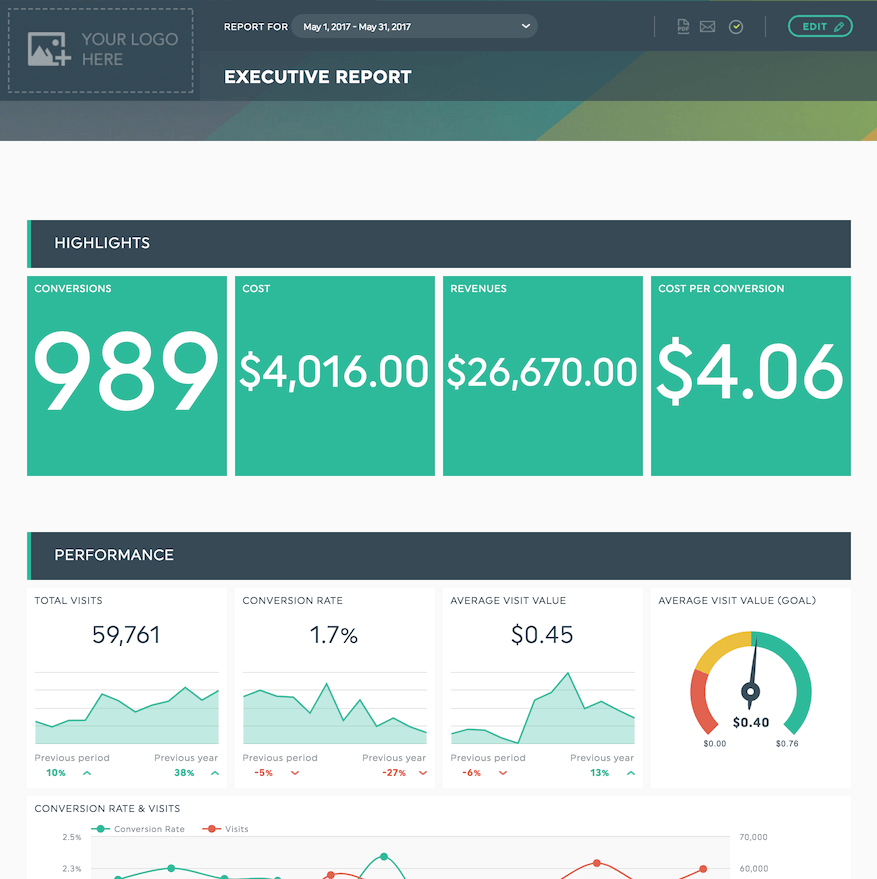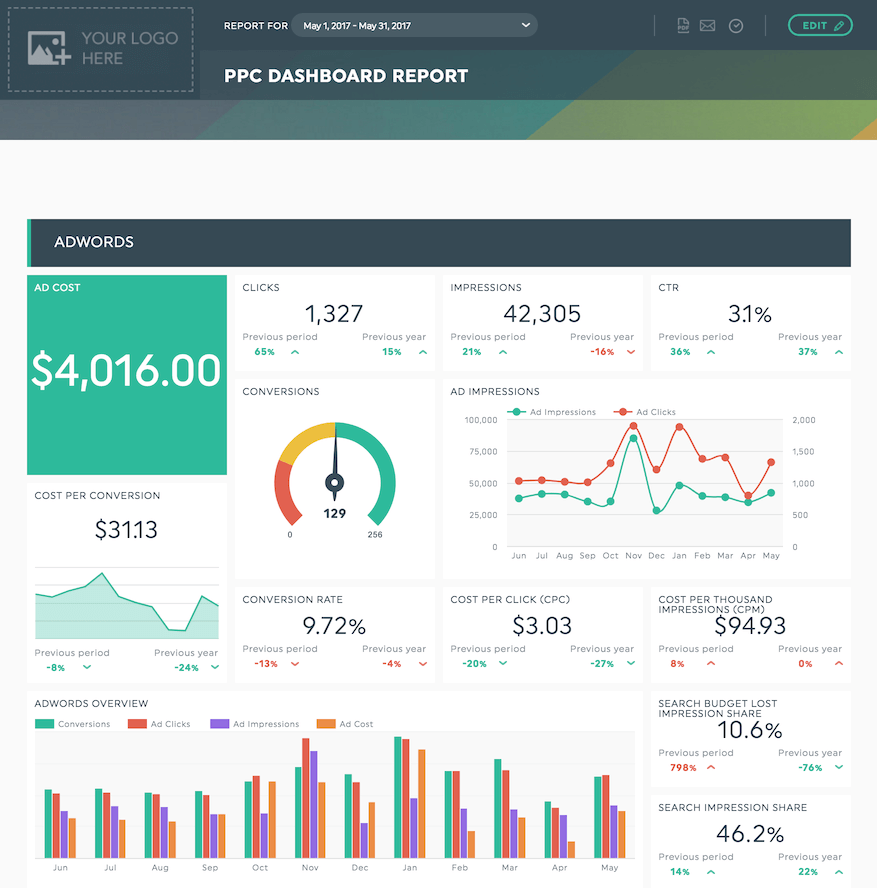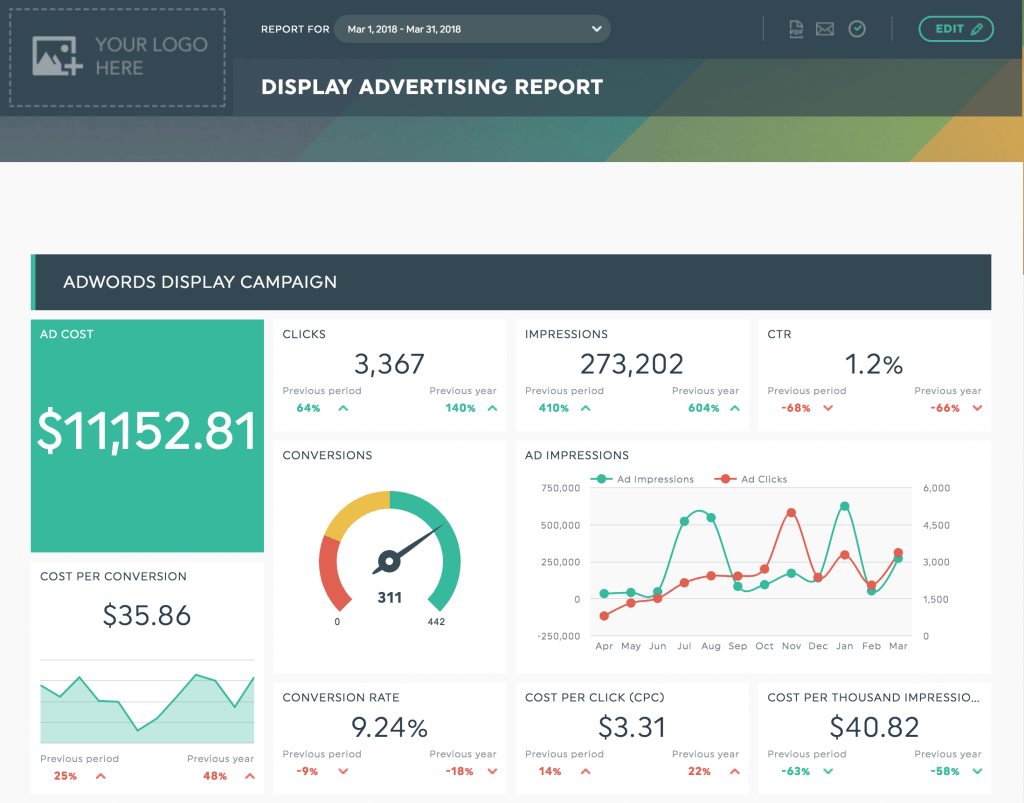Client Report Templates: the Secret to Digital Agency Success

As you know, client reporting is an integral part of a healthy agency-client relationship. But creating new client reports every month, over and over again, is a real time-suck.
But what if you could foster that healthy agency-client relationship that makes clients want to stay with you for years, without wasting time on your reporting?
Therein lies the importance of kick-ass client report templates, like this one:
See this template live | Use it with your own data
- Which Client Report Template is for you?
- Social Media Report
- SEO Report
- Executive Report
- PPC & SEM Report
- Display Ad Report
- Why Are Client Reports So Important Anyway?
- A Client Report Template Gives you All the Benefits for Half the Effort
- How to Write a Client Report? Know Your Client
- A Client Report Template Gives you Wings!
- The Client Report Template, in a Nutshell
Which Client Report Template is for you?
Here at DashThis, we have a ton of agency clients, each of whom has their own type of clientele; no two clients are the same.
However, a lot of the agencies that use our system tend to at least START with a preset client report template, and then work out from there, personalizing the client report for each individual.
This gets them off to a running start since they aren’t starting from zero every time. And since, as we know, time is of the essence in agency life, it’s important to use all the tools we have in our arsenal to save time on redundant tasks like reporting.
Less time reporting + more time creating campaigns = happier clients + clients who come back time and time again = bigger bottom line.
Now I’m not a math person, but that’s an equation I can get behind.
So apart from client-specific details that we’ll get into later, what should the base of each type of client report template include?
Ahhh, don’t worry, we’ve figured all this out for you!
Our team of reporting experts have put together the basics for each type of report, no matter what field of marketing you might want to report on!
Social Media Report
Social media is big right now (and has been for a long time, as you know). Digital marketing campaigns that don’t include a social media aspect are few and far between!
So if you’ve been managing your client’s social media presence, your report should always include:
- Reach & Impressions (is the content you’re producing getting seen),
- Fans & Likes (are people joining your community),
- Engagement Rate (are they reacting to your content),
- Visits originating from social media (are people moving from your social networks to your main site),
- Conversions originating from social media (are they buying what you’re selling, so to speak).
You’ll most likely be using a combination of multiple tools, such as Facebook, Facebook Ads, Twitter, LinkedIn, LinkedIn Ads, Instagram, YouTube, and maybe more. You should make sure that you’re including all your tools in order to give an accurate picture of exactly how each network behaves and plays off each other.
SEO Report
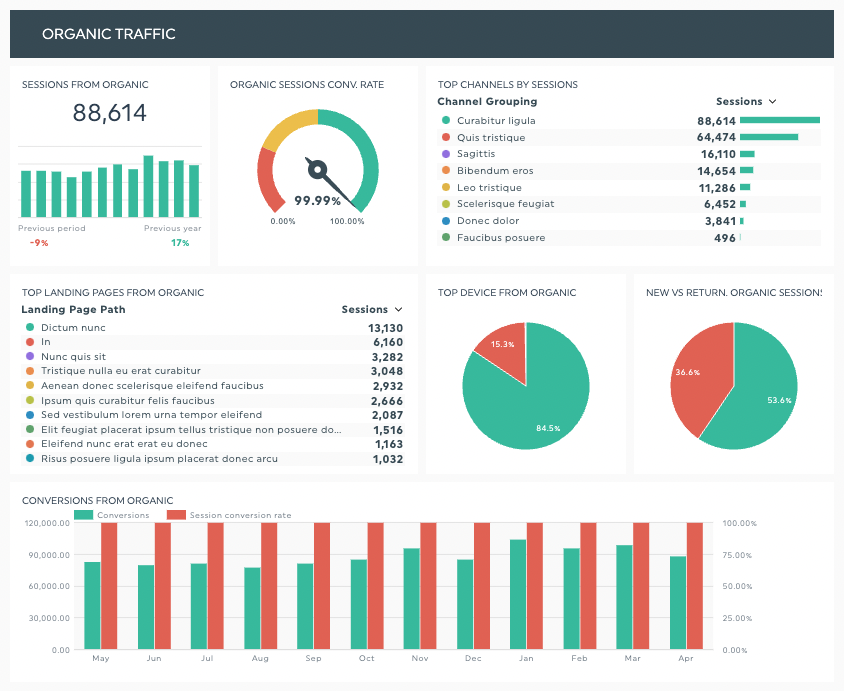
Ahh, the ever subtle yet oh-so-important search engine optimization.
You can have the sweetest and coolest looking website ever, but if search engines aren’t finding it, it won’t do jack.
And that’s why there are a few metrics that should always be included in every effective SEO report:
- Keywords (what are your users looking for when they find you),
- Backlinks (do you have them and are they giving you relevant traffic),
- Organic Search Traffic (how many of your visitors are finding you organically… which is really the entire point of SEO… right?),
- Pages per Visitor (once visitors get to your page, are they poking around or just getting out quick),
- Returning Users (are they coming back for more),
- Conversions (the mother of all metrics… do they want what you have).
Again, SEO uses multiple tools to go through every KPI and get the most accurate data. Useful tools can include Google Analytics (because of course), Moz, Ahrefs, SEMrush, Google Search Console, MajesticSEO, GinzaMetrics, and Searchmetrics. Collect them all!
Executive Report
If the person you’re presenting your report to is more high-level, and therefore perhaps not as well versed in data as you or your other clients are, too many detailed metrics are just going to overwhelm him/her.
What kind of numbers do speak to a more high-level executive type?
Money. And lots of it.
You want to show that you aren’t just spending their money… you’re making it for them. And that’s why you’re creating an executive report for them: to prove that you’re worth it.
Your high-level executive report should include:
- Cost (how much did you spend),
- Revenue (how much did you make),
- Conversions (how many people bought what you’re selling),
- Cost per Conversion (how much did each person cost you to bring in),
- Average Visit Value (how much money comes in for every visitor to your site).
Basically, these metrics should be able to easily show your client the influx and outflow of money you’re responsible for.
Executive reports are one of those types of reports that might include data from several of any digital marketing tool that exists on the market. Any tool that can show you a money metric is one that you can potentially include in this report.
PPC & SEM Report
Your agency probably has at least one in-house PPC/SEM expert, right? The reason for this is pretty simple: PPC and SEM ROI is far easier to quantify quickly and accurately than many other marketing methods.
Easily quantifiable, high ROI, built-in recurring revenue… that’s why PPC really is the digital agency’s bread and butter. And that’s why a great PPC & SEM report template is a non-negotiable for most agencies!
Your PPC & SEM report should probably include:
- Conversions (what else),
- Cost (how much did you spend),
- Cost per Click (how much did each lead cost),
- Ad Impressions (how many people saw your ads),
- Click-through rate (how many people liked what they saw),
- Cost per Conversions (was it worth it, in the end).
Google Ads, Bing Ads, DoubleClick Search, Facebook Ads, LinkedIn Ads, DoubleClick Campaign Manager, Google Analytics… although there is a myriad of tools to use for PPC/SEM, it’s important that they all be tracked and reported together. You – and your client – need to see your entire campaign across all channels, not just a small part of it!
Display Ad Report
Digital display ads are some of the most lucrative and persuasive tools we have.
And that persuasiveness should be measured in a Display Ad report. Again, due to the sheer quantity of Display Advertising tools that exist on the market, and that you could potentially be using, there are a metric ton of metrics (I love puns) that you might use.
However, the basic gist is that your metrics should be showing how much your ads cost, how much traffic they caused, and how much money they ultimately brought in.
Some metrics like this include:
- Conversions (again, of course),
- View-through Conversion (how efficient were your ads even if people didn’t click),
- Cost(how much did you spend),
- Ad Impressions (how many people saw your ads),
- Frequency (how many times did the same people see your ads),
- Clicks (how many times were your ads clicked on).
Like I said, there are a lot of tools with which you can be advertising online. The biggest of these are used pretty universally: Google Ads, DoubleClick Campaign Manager, Facebook Ads, LinkedIn Ads, Instagram Ads, Adform, Smart AdServer, and everything else under the sun…
Ready to get started with these monthly client report templates (or any other from the myriad client report templates we have on hand?)
Why Are Client Reports So Important Anyway?
Considering the fact that you probably spend most of your day thinking, reflecting, and optimizing things you previously thought about… it can be pretty difficult to verbally explain how important your job is to your client.
This is where your client reports come in: they’re your words, your communication tool, and your selling point.
A great client report is like the display board you used in grade school during a class presentation: it’s a concise one-stop shop of all the information you want to share. It’s how you prove how awesome you are at what you do.
Client reports are a way for you to open the discussion with your clients, educate them on the important aspects of your work, and show them why you’re great at your job and why they should keep working with you. All of these are crucial to a healthy client/agency relationship.
What’s more, your clients want to see your results through reports!
Analytics continue to be the most asked for service by clients to agencies… so don’t neglect what your clients are asking for!
Client reporting is your way of sharing your work with your client as well as proving your worth; this is how you measure your progress, and identify any issues you might have, and otherwise make sure that you and your client are consistently working towards the same goals.
A Client Report Template Gives you All the Benefits for Half the Effort
If you’re building a house, having a model blueprint makes the process of building so much quicker than starting everything from scratch every time… right?
A client report is no different. That’s why you need a client report template: it allows you to build out from an existing frame, saving you tons of time, yet giving you the same benefits.
I’d call that a win-win.
So…. regardless of whether you’ve picked out a specific client report sample that we mentioned above or not, what should you always keep in mind when creating your first… or your tenth… client report?
No matter your client, who they are, and what they do, every client report template you create should include a place for you to include context and explanations. By looking at their report, you clients should be able to answer:
- What happened or didn’t happen this month?
- What changed caused this?
- What are you, as an agency, going to do next month to change these results?
Your clients need to see, at a glance, not only their hard numbers, but also context as to what are good numbers and what are bad numbers… this is where your notes and comments sections come in handy.
And remember, no matter what you’re telling your clients, no matter the type of client report template you’re using for their particular situation, it’s important to always keep the discussion in the “we” or “us”. After all, you may think you’re working for your client, but in reality, the client/agency relationship is that of a team. By keeping your language in the “us” tone, your client will feel involved every step of the way.
And isn’t that what client reporting is all about?
Because while you should always be available to talk to your client one-on-one whenever (s)he needs it, if your report is clear, concise, and provides ample context, your client might not need to take up more of your time.
So you can focus on actually doing the work you love to do.
How to Write a Client Report? Know Your Client
In the monthly client report template world, good things come in small packages.
What I mean is, a client report should only include metrics that matter to your client’s goals. If you can’t identify your client’s goals just by looking at the report… you’ve probably got way too many metrics thrown in there.
This is where you have to truly know your client and his/her goals. I don’t just mean the name of the brand, what field their in, and what their budget is. Those are given. At the start of any project, you have to actually sit down with them, and go through what they want to accomplish, in how long, what their brand image looks like, their mission, their client base… everything.
If you imagine this like a romantic relationship, this is like the figurative 1st, 2nd, and everything up to the 23rd date combined.
Here are some things that you should know about your client in order to create the right report template:
1) Your client’s data knowledge
- The client’s level of comfort with data and analytics tells you how detailed and/or high-level you need to be in terms of what data you present.
2) Your relationship with your client
- Where are you in the relationship with the client? Is this a new relationship, a new project, or have you been working together for a while now? These answers will help indicate how far back in the data you’ll be going, and what kind of and how much historical context you can provide.
3) Your project’s scope
- What speciality is your client and/or your project in (SEO, social media, business analytics, display advertising, a combination of these)? This will inform the types of tools you’ll be using and thus integrating in your report, as well as the types of metrics you’ll be looking at.
4) Your project’s timeline
- What is your project timeline or the frequency at which your client wants and needs to know how things are going? This will tell you how often you’ll be producing reports, and perhaps, if you’ll be creating different types (one type for a quarterly report, and another for the monthly check-in, for example).
5) Your client’s goals
- Finally, you need to know what goals your client has; obviously, this allows you to pinpoint exactly the metrics you’ll want to show… and only those metrics please!
A Client Report Template Gives you Wings!
Think of your client report template as your wings. Now you have to fly… which is infinitely easier with those spiffy wings.
Now that you have your handy template, you don’t actually have to spend hours cutting and pasting data from one place to another, making a report, and doing the whole thing over again in a month.
And what are you going to do with all that extra time and energy? Take your template and add to it, play with it, write some context, change your data presentation depending on what you’re showing, explain why something went really well this month, and how you’re going to fix what didn’t go so well.
If you haven’t tailored your report template to fit your exact client, you’ve missed the point.
With your newfound time, you can actually do what your brain was made to do: create kick-a** campaigns for your clients.
And with your amazingly clear and beautiful reports, your clients will KNOW that your campaigns are making them money, and they’ll keep coming back for more.
The Client Report Template, in a Nutshell
So you want to create some useful client report templates to save yourself some time and create more recurring business with your clients?
No problem, here’s what you need to do:
- Remember how important client reports are to creating lasting client-agency relationships and fostering recurring revenue.
- Choose the type of client report template you need; social media, SEO, executive, PPC, Display?
- Tailor your report template to your client’s needs, understanding, and goals.
- Find yourself an automated reporting tool that does the heavy lifting for you!
Speaking of which, DashThis has a ton of prebuilt client report templates for you to choose from to get started. But we wouldn’t be good at what we did if that wasn’t the case… right?
You choose the template that works best for you and your client, customize it until it’s exactly what you want, and then keep it in your back-pocket for all your client reporting needs.
More time, better work, and happier clients… what are you waiting for?
Try these templates with your own data!
Read More
Don’t miss out!
Automate your reports!
Bring all your marketing data into one automated report.
Try dashthis for free